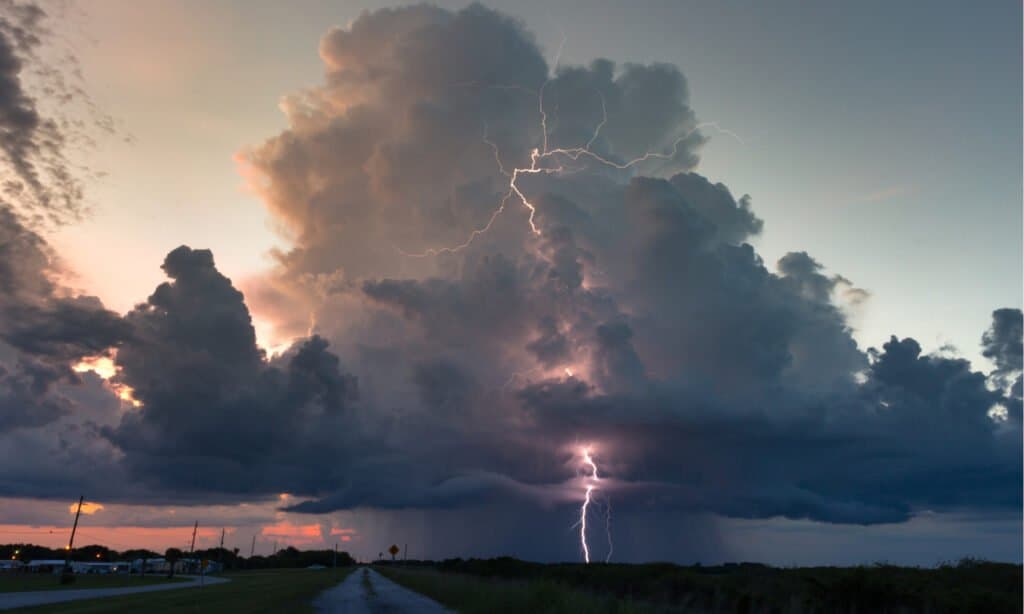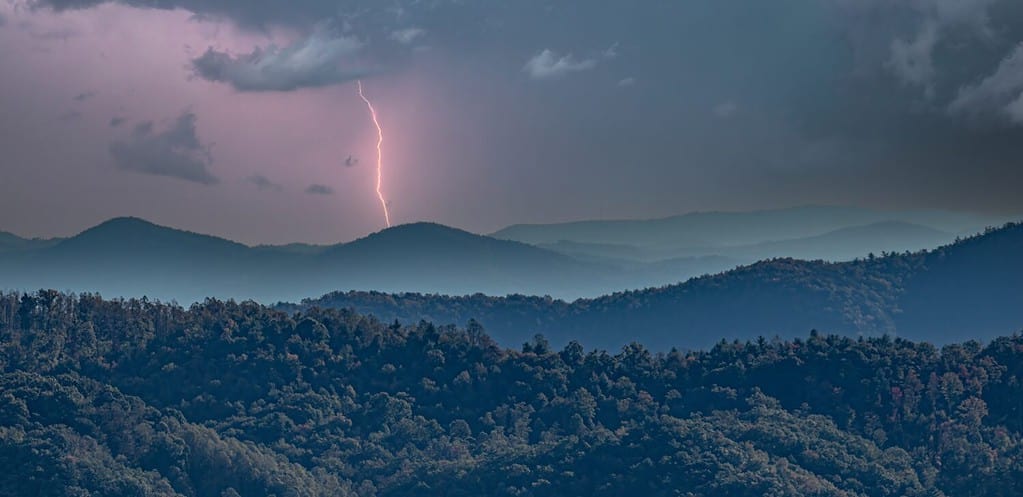Lightning is a shocking force of nature. It can come in short bursts, lighting up the sky. On April 29, 2020, National Oceanic and Atmospheric Administration recorded the world’s longest flash at a horizontal distance of 477 miles. It was recently certified by the World Meteorological Organization (WMO) as the longest lightning strike. The flash stretched from the central coast of Texas, crossed Louisiana, and ended in Southern Mississippi.
The WMO also recorded the greatest duration for a single lightning flash at just over 17.1 seconds on June 18, 2020, a record that still stands today. The flash developed through a thunderstorm over Uruguay and Northern Argentina.

The world record-setting lightning strike spanned three states but was of no real danger to anyone.
©Azovsky/Shutterstock.com
History of Longest Lightning Strikes
The new record of the longest flash beat out the old one by 37.28 miles (60 km). This one happened across Southern Brazil on Oct. 31, 2018, at 440.6 miles.
All of these records occurred in hotspots for Mesocoscal Convective System (MCS) thunderstorms. The MCS hotspots are mainly the Great Plains in North America and the La Plata Basin in South America. These storms are common over large landmasses close to the equator, and the temperature dynamics of the storms allow jaw-dropping extremes to develop.
The previous longest duration record was only .37 seconds shorter at 16.73 seconds. This flash developed over Northern Argentina on March 4, 2017.
What is Lightning?

Lightning always comes before thunder. In fact, it creates thunder.
©Jeff Gammons StormVisuals/Shutterstock.com
Lightning is a release of electrical energy. It is a gigantic spark that is dangerous and deadly. And not all lighting is visible. Sometimes it can occur between clouds. However, if lightning occurs between a cloud and the ground, we see it. The negative and positive charges in the cloud and ground produce this type of lightning.
The negative charge comes from the bottom of the cloud, and the positive charge comes from the ground. This imbalance creates a current. Lightning occurs when this imbalance is great enough and needs correcting.
Is Lightning Dangerous?
Yes. A lighting strike is about five times hotter than the surface of the sun. However, 54,000 degrees of energy doesn’t kill many people per year. According to the National Weather Service, lightning is one of the leading causes of weather-related fatalities. It is responsible for an average of 49 deaths per year. The odds of getting struck by lightning in a given year are less than one in a million. However, almost 90% of all victims survive.
Also, both of the world record-holding events were considered cloud-to-cloud flashes. This means the sky lit up thousands of feet above the ground, therefore no one was in danger. The events occurred because a negatively charged cloud attracted a positively charged cloud. No lightning struck the ground and only traveled from one cloud to another.
Does Lightning Only Occur During a Thunderstorm?
No. Other natural events such as large forest fires, volcanic eruptions, snowstorms, and hurricanes also cause lightning.
Lighting Facts:
| Question | Answer |
|---|---|
| Type of Energy | Electrical |
| Speed | 670 Million Miles Per Hour |
| Will Kill You? | Yes |
| Found Around the World? | Yes |
| How Hot Can It Get? | as high as 50,000 degrees Fahrenheit |
What Is a Megaflash?
A megaflash is a horizontal lightning discharge that is hundreds of miles long. The new world record for the longest lighting flash in length was considered to be a megaflash. It was the result of an incredibly intense conductive thunderstorm or as previously stated, MCS. These thunderstorms commonly occur in spring. They also are not associated with weather fronts. They travel for hundreds of miles and last for multiple seconds. Though these types of storms are rare, they obviously do occur.
Are Megaflashes Dangerous?
No more than regular lightning. Just because a megaflash has a larger, more extensive lighting flash, it doesn’t mean that flash carries more energy. However, megaflashes are harder to predict because the cloud systems from which they originate are vast. A person could think the storm passes but is caught by surprise when a megaflash occurs seemingly out of nowhere.
At the moment, megaflashes are an uncommon occurrence. They make up only 1% of lightning flashes overall. However, with climate change and global warming, this could change. These storms that create megaflashes may increase, thereby increasing the frequency of megaflashes.
How Are Megaflashes Recorded?
Space-based lighting mapping allows researchers to measure the duration and distance of megaflashes. Before this technology, scientists could only use ground-based lightning mapping networks. Also, additional countries have adopted weather satellite technology. This means researchers now have access to a larger database. So, megaflashes forecasted in Eastern countries such as China and India, areas that don’t have long-term records established, will now be recorded.

Megaflashes aren’t necessarily more dangerous than regular lightning.
©Bob Pool/Shutterstock.com
How To Be Safe from Lighting
If you are in a thunderstorm, it is smart to reach a lightning-safe place. This means going inside substantial buildings that have secure wiring and plumbing. Structures on a beach or something along the lines of a bus stop are not safe. If a substantial building is not an option, try to get inside a fully enclosed metal-topped vehicle. In extreme cases, lighting can arrive within seconds over long distances, so move quickly to your safe location.
Comparison of Lightning Strike
This incredible force of nature is equivalent to the air distance between New York City and Columbus, Ohio, or the distance between London and the German city of Hamburg. Here are some other comparisons:
- The length of Lake Superior: 349.8 miles
- The length of New Mexico: It is the fifth-longest state to drive through, stretching around 370 miles from north to south.
- Paris, France to London, England: 383.2 miles
- Chicago, Illinois to Pittsburgh, Pennsylvania: 461.5 miles
Other Lightning Records
| Event | Location | Record |
|---|---|---|
| Highest Concentration | Catatumbo, Venezuela | 250 flashes per sq km each year |
| Most Strokes | New Mexico | 26 pulses in single flash |
| Longest | Texas, Louisiana, Mississippi | 477 miles (767 km) |
| Longest Lasting | Uruguay and Argentina | 17.1 seconds |
Conclusion
Space imaging caught a new world record megaflash that stretched 477 miles across three states. It is the furthest-reaching lightning flash on record. The space technology caught the monster lightning flash as well as the longest-duration flash in South America. That lasted 17.1 seconds. We continue to learn more about these types of storms with advanced technology.
The photo featured at the top of this post is © iStock.com/HairFacePhoto
Thank you for reading! Have some feedback for us? Contact the AZ Animals editorial team.







